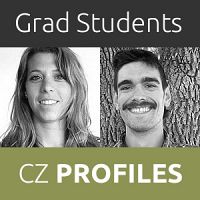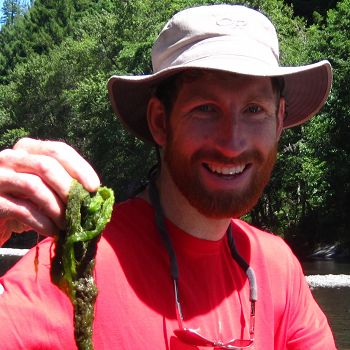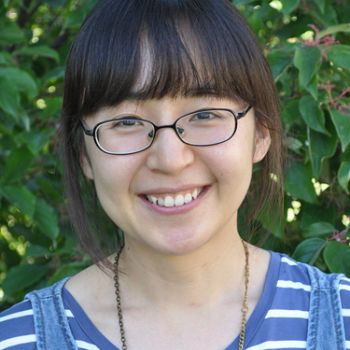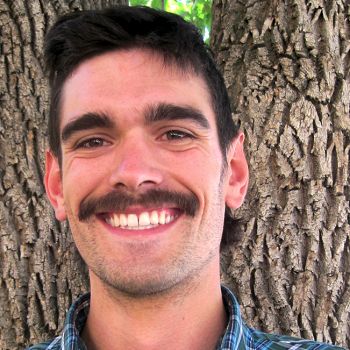Critical Zone Profiles - Meet the people doing CZO science (Graduate Students)
What kind of work do critical zone graduate students do? Who are some of the students working at Critical Zone Observatories across the country? How does their work inform our understanding and management of critical zone resources, such as water, soil, and food?
These brief profiles feature just a few of the 250+ senior scientists, university faculty, postdoctoral researchers, and graduate students who work at the nine CZO sites currently funded by the National Science Foundation. CZO people are cross-disciplinary scientists who have expertise in fields including hydrology, geochemistry, geomorphology, ecology, biology, and climatology. More profiles will be added over time, as new scientists join the CZO teams.
The profiles provide a non-technical introduction to the work CZO students do. Each scientist was asked to respond to the following questions:
1. What is the goal of your work?
2. How is your work relevant to the science community and to the larger human communities in which we live?
3. Why is studying the critical zone important?
4. How has the CZO network been valuable to you in your work?
5. How can the CZOs help improve our understanding and management of natural resources?
Profiles: Grad Students | Early Career | Boulder | Calhoun | Catalina-Jemez | Eel | IML | Luquillo | Reynolds | Shale Hills | Southern Sierra | and more profiles coming
GRADUATE STUDENT PROFILES
CARLOS OROZA (systems engineer, PhD student)
Carlos Oroza designs and deploys wireless sensor networks to monitor real-time changes in the water supply. At the Southern Sierra CZO, Oroza – along with CZO staff and other researchers – maintains a 23-node wireless sensor network that provides spatially-distributed measurements of snow, soil moisture, solar radiation, temperature, and relative humidity. Data from the sensors is transferred through a wireless network and uplinked to provide researchers with real-time information. Visit Carlos's profile >
CHRISTOPHER SHEPARD (soil researcher, PhD student)
My research provides insights into how soil properties change across watersheds and at different depths. The primary goal of my research is to find new ways to map how soils change across a watershed using a technique called digital soil mapping, or DSM. We can apply DSM techniques and gain insights into how certain soil properties are distributed across a watershed or across an agricultural field. While we often think of agricultural fields as being relatively uniform, in reality, the soil properties from one yard to the next may be quite different. If a farmer had a better understanding of which nutrients were available across her field, she could use less fertilizer, potentially saving money as well as limiting pollution. Visit Christopher's profile >
DANIELLA REMPE (hydrologist, geomorphologist, PhD student)
Scientists don’t yet fully understand how the critical zone is structured and what controls the movement of water and nutrients through the subsurface system that supports life. Studying the critical zone directly helps us understand how this zone evolves and how it affects hydrologic and ecologic processes. Daniella Rempe seeks to understand... Visit Daniella's profile >
JAIVIME EVARISTO (ecohydrologist, PhD student)
Jaivime Evaristo is an ecohydrologist who seeks to understand how vegetation dynamics in general, and root-water uptake in particular, affect stores of water and nutrients from hillslope to ecosystem and continental scales. He uses geochemical tracers (mostly stable isotopes) to improve our model representations of local to regional and global water fluxes. Visit Jaivime's profile >
JASPER OSHUN (environmental scientist, PhD student)
California and the Western United States are currently experiencing severe drought. I grew up in Sebastopol, California, in a water-conscious family. I went to school at Brown and returned to California in Fall 2006. In my lifetime I've seen widespread changes in land cover in Sonoma County – from apple orchards, savannah, and redwood forests to vineyards. Vineyards are thirsty, taking water from the Russian River. Runoff from vineyards also delivers large amounts of fine-grained sediment to the river, which warms the water temperature, making the river less hospitable for fish. Visit Jasper's profile >
KEITH BOUMA-GREGSON (freshwater ecologist, PhD student)
Keith Bouma-Gregson is a river ecologist studying algae in the Eel River, located in the Coast Range Mountains of Northern California. Algae are foundational to the summertime food web. Insects and fish feed on the high algal productivity that the river supports. However, some algae negatively affect the river ecosystem. Cyanobacteria, or blue-green algae, can produce toxins which are harmful to humans, pets, and livestock. Bouma-Gregson is researching the ecology of cyanobacterial mats. He and his colleagues are studying whether drought and low-flow conditions promote the growth of cyanobacteria over other non-toxic algae. The goal of this research is to better predict when and where cyanobacterial mats will occur, and then inform river management to reduce the frequency of these mats. Visit Keith's profile >
KYUNGJIN (KJ) MIN (soil ecologist, PhD student)
Although microorganisms cannot be seen with the naked eye, they play an important role in mediating the cycling of key nutrients, such as carbon and nitrogen. Microbial CO2 respiration represents up to 60 percent of soil respiration on the planet—significantly contributing to anthropogenic CO2 emission and climate change. Yet, we still do not know how changing environments will influence microbially-mediated nutrient cycling. KJ Min’s work in the Calhoun CZO investigates the effects of environmental changes on microbial activities in soils, in order to better predict future microbial activities in a changing climate. Visit Kyungjin (KJ)'s profile >
LINDSAY ARVIN (geomorphologist, PhD student)
Working at the Southern Sierra CZO, Lindsay Arvin will look at the processes within the critical zone that govern where vegetation grows, what kind of vegetation can grow, and the impacts that this vegetation has on erosion – both chemical and physical – of the Sierras. Studying links between bedrock, vegetation, and erosion, Arvin hopes to interpret the intricate role that bedrock has on shaping the Earth. Visit Lindsay's profile >
MELISSA FOSTER (geologist, PhD student)
Melissa Foster is a geologist studying how the Colorado Front Range landscape has evolved over time. The goal of Foster’s work is to quantify the rates at which this landscape is evolving. Some of the broad questions Foster is addressing... Visit Melissa's Profile >
MELISSA THAW (mountain hydrologist, PhD student)
Melissa Thaw will use isotopes as tracers to track water through the mountain system. These tracers will also allow Thaw to understand where trees get their water during drought conditions. By combining ground-based data with remote sensing techniques, Thaw will study the movement of water seasonally and across the landscape. Visit Melissa's profile >
THEODORE BARNHART (hydrologist, PhD student)
Theodore Barnhart is looking at how changes in snowmelt timing and rate alter the balance between forest water use and streamflow. His research addresses essential questions... Visit Theodore's Profile >
XAVIER ZAPATA-RIOS (hydrologist, PhD student)
The Critical Zone (CZ) is a very thin surficial layer of the planet that extends from the base of the weathered bedrock to the top of the vegetation canopy. The CZ is the place where atmosphere, water, solar energy, plants, and rocks interact and drive chemical, physical, biological, and geological processes. This is the layer of the planet that sustains life. As part of my PhD investigation, I have been studying how mineral weathering influences soil development and releases nutrients to the soil and water. This is one of the fundamental processes we are trying to understand as it involves the consumption of CO2 from the atmosphere and defines the chemical composition of natural waters. Visit Xavier's profile >
Related News
Explore Further















